Modelling of the Luminance Coefficient in the Light Scattered by a Mineral Mixture Using Machine Learning Techniques
Abstract
1. Introduction
2. Materials and Methods
2.1. Aggregate
2.2. Luminance Ratio
2.3. Diffuse Luminance Coefficient Qd and Surface Reflectance Coefficient RL
2.4. Test Stand for Measuring the Luminance Ratio
2.5. Validation of the Method
- Two operators;
- Two reflectometers;
- Four randomly selected aggregate samples (light and dark).
2.6. Mineral Mix Grading Curves
2.7. Polarising Microscope Examination
3. Results
3.1. Luminance Coefficient Qd of the Aggregate vs. Mineralogical Composition
3.2. Regression Model of Aggregate Luminance Coefficient Taking Petrography into Account
- Root mean square error (RMSE);
- R-squared (R2);
- Mean absolute error (MAE).
3.3. Regression Model of the Luminance Ratio for the Mineral Mixture
- Random forest (RT);
- Neural network (ANN);
- Reinforced random trees (BT);
- Classical random trees (C&RT);
- Multi adaptive regression splines (MARS).
- nrounds—controls the maximum number of iterations;
- η—controls the learning rate;
- γ—controls regularisation (or prevents overfitting);
- max depth—controls the depth of the tree;
- min. child weight—refers to the minimum number of instances required in a child node;
- subsample—controls the number of samples (observations) supplied to a tree.
4. Conclusions
- The use of machine learning techniques is an excellent tool for modelling the luminance ratio of aggregates and mineral mixtures;
- The inclusion of a thorough petrographic analysis in the prediction of the aggregate luminance ratio resulted in some improvement in the prediction of the aggregate luminance ratio compared to the case in which its influence was expressed solely by the name of the aggregate;
- The mineral that was most decisive in the division between dark and light aggregates was pyroxene, which was characteristic of igneous rocks such as basalt and melaphyre;
- The mineral that is probably responsible for the increased reflectivity (nighttime visibility) was mica found in quartzite sandstone, among others;
- The best results in terms of surface brightening with Qd > 70 mcd·m−2·lx−1 were obtained with quartzite sandstone (sedimentary) and granite (igneous), in which the quartz mineral predominated. In contrast, the sedimentary rock class was limestone, which contained mainly calcite;
- The amplified random tree (BT) technique used, supported by additional tuning and cross-check (test set) procedures, allowed the construction of a stable BT model characterised by an absolute error of MAE = 5.7 mcd⋅m−2⋅lx−1 and RMSE = 4.4 mcd⋅m−2⋅lx−1. The correlation value of the predicted values against the observed values was 87%. The present model effectively eliminated the singularities present, minimising outliers;
- The greatest influence on the construction of relationships in the amplified random tree model was the percentage and value of the luminance ratio of mainly the 2/5 and 2/8 fractions;
- An analysis of the individual impact of variables on the variability of the predicted BT model indicates that the use of light aggregate fractions with a grain size of 2/5 in quantities >40% or light aggregate 8/11 in quantities of 60% provides a rapid improvement in the degree of lightening of the mineral mixture;
- The presence of 5/8 fraction quartzite sandstone showed the best results in terms of brightening the mineral mix. In contrast, a sharp decrease in the luminance coefficient was recorded in mineral mixtures in which basalt aggregate occurring in the 5/8 fraction was used;
- It is important to note that the machine learning technique adopted was chosen as the most effective due to its quality in predicting the luminance coefficient. This does not mean that other techniques will not be effective. The development of artificial intelligence can provide new models with architectures that will be decidedly better than the BT technique. The authors of this publication are still working on improving the machine learning model.
Author Contributions
Funding
Institutional Review Board Statement
Informed Consent Statement
Data Availability Statement
Conflicts of Interest
References
- Filipczyk, M.; Kukielska, D. Bright and Bleached Surfaces. Theory and Practice. Min. Sci. 2016, 23, 17–22, ISSN 2300-9586. [Google Scholar] [CrossRef]
- Onaygil, S. Road Lighting Calculations; CIE Technical Committee 4-15 of Division 4 “Transportation and Exterior Applications”: Vienna, Austria, 2000; ISBN 978-3-901906-54-1. [Google Scholar]
- Strbac-Hadzibegovic, N.; Strbac-Savic, S.; Kostic, M. A New Procedure for Determining the Road Surface Reduced Luminance Coefficient Table by On-Site Measurements. Light. Res. Technol. 2019, 51, 65–81. [Google Scholar] [CrossRef]
- Van Bommel, W.J.M.; Burghout, F.; Cobb, J. Road Surfaces and Lighting: Joint Technical Report CIE/PIARC; CIE Central Bureau: Vienna, Austria, 2008; ISBN 978-3-901906-72-5. [Google Scholar]
- Bodmann, H.W.; Schmidt, H.J. Road Surface Reflection and Road Lighting: Field Investigations. Light. Res. Technol. 1989, 21, 159–170. [Google Scholar] [CrossRef]
- Van Tichelen, P.; Jansen, B.; Geerken, T.; Vanden Bosch, M.; Van Hoof, V.; Vanhooydonck, L.; Vercalsteren, A. Final Report Lot 9: Public Street Lighting; European Commission: Brussels, Belgium, 2007. [Google Scholar]
- Adrian, W.; Almasi, S.; Arens, J.B. Calculation and Measurement of Luminance and Illuminance in Road Lighting: Computer Program for Luminance, Illuminance and Glare, 2nd ed.; Internationale Beleuchtungskommission, Ed.; Technical Report; Reprint; CIE Central Bureau: Vienna, Austria, 1990; ISBN 978-92-9034-030-0. [Google Scholar]
- Zieja, M.; Wesołowski, M.; Blacha, K.; Iwanowski, P. Analysis of the Anti-Skid Properties of New Airfield Pavements in Aspect of Applicable Requirements. Coatings 2021, 11, 778. [Google Scholar] [CrossRef]
- Šrámek, J.; Kozel, M.; Remek, L.; Mikolaj, J. Evaluation of Bitumen Modification Using a Fast-Reacting SBS Polymer at a Low Modifier Percentage. Materials 2023, 16, 2942. [Google Scholar] [CrossRef] [PubMed]
- Ylinen, A.-M.; Pellinen, T.; Valtonen, J.; Puolakka, M.; Halonen, L. Investigation of Pavement Light Reflection Characteristics. Road Mater. Pavement Des. 2011, 12, 587–614. [Google Scholar] [CrossRef]
- PKN-CEN/TR 13201-1:2016-02; Road Lighting. The Polish Committee for Standardization: Warsaw, Poland, 2016.
- Sørensen, K.; Nielsen, B. Road Surfaces in Traffic Lighting. 1974. Available online: https://trid.trb.org/view/37817 (accessed on 18 June 2024).
- Bonomo, M.; Burghout, F.; Hautala, P.; Marinier, J.C.; Simons, R.H.; Stark, R.E.; Stockmar, A.; Vermeulen, J. Design Methods for Lighting of Roads; Internationale Beleuchtungskommission, Ed.; CIE Central Bureau: Vienna, Austria, 1999; ISBN 978-3-900734-92-3. [Google Scholar]
- Qin, L.; He, S.; Yang, D.; Leon, A.S. Proposal for a Calculation Model of Perceived Luminance in Road Tunnel Interior Environment: A Case Study of a Tunnel in China. Photonics 2022, 9, 870. [Google Scholar] [CrossRef]
- Mazurek, G.; Bąk-Patyna, P. Application of Data Mining Techniques to Predict Luminance of Pavement Aggregate. Appl. Sci. 2023, 13, 4116. [Google Scholar] [CrossRef]
- Montgomery, D.C. Design and Analysis of Experiments, 8th ed.; John Wiley & Sons, Inc: Hoboken, NJ, USA, 2013; ISBN 978-1-118-14692-7. [Google Scholar]
- Rebelo, F.J.; Martins, F.F.; Silva, H.M.; Oliveira, J.R. Use of Data Mining Techniques to Explain the Primary Factors Influencing Water Sensitivity of Asphalt Mixtures. Constr. Build. Mater. 2022, 342, 128039. [Google Scholar] [CrossRef]
- Gong, H.; Sun, Y.; Mei, Z.; Huang, B. Improving Accuracy of Rutting Prediction for Mechanistic-Empirical Pavement Design Guide with Deep Neural Networks. Constr. Build. Mater. 2018, 190, 710–718. [Google Scholar] [CrossRef]
- Guo, X.; Hao, P. Using a Random Forest Model to Predict the Location of Potential Damage on Asphalt Pavement. Appl. Sci. 2021, 11, 10396. [Google Scholar] [CrossRef]
- Phan, T.M.; Jang, M.-S.; Seo, J.-W.; Yoon, J.-H.; Park, D.-W.; Minh Le, T.H. Impact of Air Voids and Environmental Temperature of Asphalt Concrete on Black Ice. Road Mater. Pavement Des. 2023, 24, 91–106. [Google Scholar] [CrossRef]
- Fakhri, M.; Shahni Dezfoulian, R. Pavement Structural Evaluation Based on Roughness and Surface Distress Survey Using Neural Network Model. Constr. Build. Mater. 2019, 204, 768–780. [Google Scholar] [CrossRef]
- Gopalakrishnan, K.; Agrawal, A.; Ceylan, H.; Kim, S.; Choudhary, A. Knowledge Discovery and Data Mining in Pavement Inverse Analysis. Transport 2013, 28, 1–10. [Google Scholar] [CrossRef]
- Bashar, M.Z.; Torres-Machi, C. Performance of Machine Learning Algorithms in Predicting the Pavement International Roughness Index. Transp. Res. Rec. 2021, 2675, 226–237. [Google Scholar] [CrossRef]
- Tong, Z.; Gao, J.; Sha, A.; Hu, L.; Li, S. Convolutional Neural Network for Asphalt Pavement Surface Texture Analysis: Convolutional Neural Network. Comput.-Aided Civ. Infrastruct. Eng. 2018, 33, 1056–1072. [Google Scholar] [CrossRef]
- Corte-Valiente, A.; Castillo-Sequera, J.; Castillo-Martinez, A.; Gómez-Pulido, J.; Gutierrez-Martinez, J.-M. An Artificial Neural Network for Analyzing Overall Uniformity in Outdoor Lighting Systems. Energies 2017, 10, 175. [Google Scholar] [CrossRef]
- Kazanasmaz, T.; Günaydin, M.; Binol, S. Artificial Neural Networks to Predict Daylight Illuminance in Office Buildings. Build. Environ. 2009, 44, 1751–1757. [Google Scholar] [CrossRef]
- Kayakuş, M.; Üncü, İ.S. Basketbol Salonlarının Parıltısının Makina Öğrenme Yöntemleriyle Tahmini. Düzce Üniversitesi Bilim Ve Teknol. Derg. 2020, 8, 2468–2479. [Google Scholar] [CrossRef]
- WT-1 Kruszywa Do Mieszanek Mineralno-Asfaltowych i Powierzchniowych Utrwaleń Na Drogach Krajowych 2014. Available online: https://www.gov.pl/web/gddkia/dokumenty-techniczne---ogolne (accessed on 21 June 2024).
- PN-EN 13043:2004/Ap1:2010; Kruszywa Do Mieszanek Bitumicznych i Powierzchniowych Utrwaleń Stosowanych Na Drogach, Lotniskach i Innych Powierzchniach Przeznaczonych Do Ruchu. Polish Committee for Standardization: Warsaw, Poland, 2004.
- EN 13043; Aggregates for Bituminous Mixtures and Surface Treatments for Roads, Airfields and Other Trafficked Areas. International Organization for Standardization: Geneva, Switzerland, 2013.
- EN 1097-2:2020; Tests for Mechanical and Physical Properties of Aggregates—Part 2: Methods for the Determination of Resistance to Fragmentation. International Organization for Standardization: Geneva, Switzerland, 2020.
- EN 1097-8:2020; Tests for Mechanical and Physical Properties of Aggregates—Part 8: Determination of the Polished Stone Value. International Organization for Standardization: Geneva, Switzerland, 2020.
- EN 1097-6:2013; Tests for Mechanical and Physical Properties of Aggregates—Part 6: Determination of Particle Density and Water Absorption. International Organization for Standardization: Geneva, Switzerland, 2013.
- EN 933-9:2022; Tests for Geometrical Properties of Aggregates—Part 9: Assessment of Fines—Methylene Blue Test. International Organization for Standardization: Geneva, Switzerland, 2022.
- EN 933-1:2012; Tests for Geometrical Properties of Aggregates—Determination of Particle Size Distribution. Sieving Method. International Organization for Standardization: Geneva, Switzerland, 2012.
- EN 933-3:2012; Tests for Geometrical Properties of Aggregates—Part 3: Determination of Particle Shape—Flakiness Index. International Organization for Standardization: Geneva, Switzerland, 2012.
- Boyce, P.R. Human Factors in Lighting; CRC Press: Boca Raton, FL, USA, 2003; ISBN 978-0-429-22113-2. [Google Scholar]
- van Bommel, W.J.M.; de Boer, J.B. Road Lighting; Palgrave Macmillan: London, UK, 1980; ISBN 978-1-349-05802-0. [Google Scholar]
- PN-EN 1436:2018-02; Road Marking Materials—Road Marking Performance for Road Users and Test Methods. Polish Committee for Standardization: Warsaw, Poland, 2018.
- Huerne ter, H.L.; Hetebrij, D.; Elfring, J. Design of Reflective Pavements for Roads. In Proceedings of the 6th Eurasphalt & Eurobitume Congress, Prague, Czech Republic, 1–3 June 2016; Czech Technical University in Prague: Prague, Czech Republic, 2016. [Google Scholar]
- Sørensen, K. Performance of Road Markings and Road Surfaces 2011. Available online: https://nmfv.dk/wp-content/uploads/2012/03/Performance-of-road-markings-and-road-surfaces.pdf (accessed on 21 June 2024).
- Serkan Üncü, I.; Kayakus, M. Analysis of Visibility Level in Road Lighting Using Image Processing Techniques. Sci. Res. Essays 2010, 5, 2279–2785. [Google Scholar]
- WT-2 Technical Guidelines 2: Asphalt Pavements for National Rtoads. Part I: Asphalt Mixes; General Directiorate for National Roads and Motorways: Poland, Warsaw, 2014.
- ISO 5725-2; Accuracy (Trueness and Precision) of Measurement Methods and Results—Part 2: Basic Method for the Determination of Repeatability and Reproducibility of a Standard Measurement Method. International Organization for Standardization: Geneva, Switzerland, 2019.
- Down, M.; Czubak, F.; Gruska, G.; Stahley, S.; Benham, D. Motors Measurement Systems Analysis, 2nd ed.; Chrysler Ford GM: Auburn Hills, MI, USA, 1998. [Google Scholar]
- EN 932-1:1999; Tests for General Properties of Aggregates—Part 1: Methods for Sampling. International Organization for Standardization: Geneva, Switzerland, 1999.
- Mineralogia Szczegółowa: Rozpoznawanie, Występowanie, Znaczenie Minerałów, 1st ed.; Mineralpress: Kraków, Poland, 2019; ISBN 978-83-933330-5-9.
- R Core Team. R: A Language and Environment for Statistical Computing; R Foundation for Statistical Computing: Vienna, Austria, 2021. [Google Scholar]
- Friedman, J.H. Greedy Function Approximation: A Gradient Boosting Machine. Ann. Stat. 2001, 29, 1189–1232. [Google Scholar] [CrossRef]
- Hill, T.; Lewicki, P. Statistics: Methods and Applications: A Comprehensive Reference for Science, Industry, and Data Mining; StatSoft: Tulsa, OK, USA, 2006; ISBN 978-1-884233-59-3. [Google Scholar]
- Nwanganga, F.; Chapple, M. Practical Machine Learning in r: <br>, 1st ed.; John Wiley and Sons: Indianapolis, IN, USA, 2020; ISBN 978-1-119-59151-1. [Google Scholar]
- Norddeutsche Expertengruppe Für Aufgehellte Asphaltdeckschichten: Praktische Hinweise Für Den Bau von Hellen Asphaltdeckschichten. Broschüre 2004, zu beziehen bei Norddeutsche Asphaltmischwerke, Niederlassung Hamburger Asphaltmischwerke, 2004.
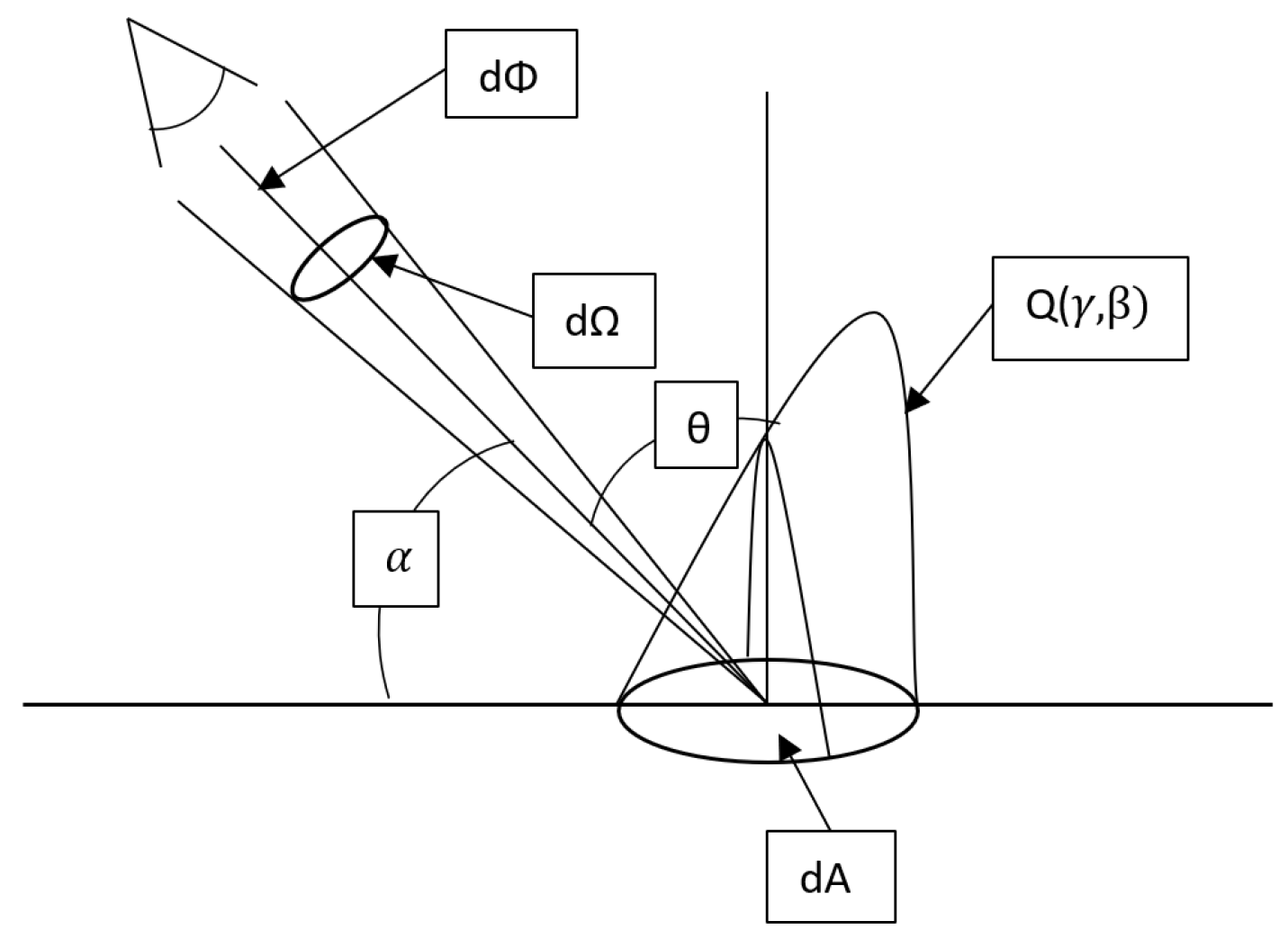
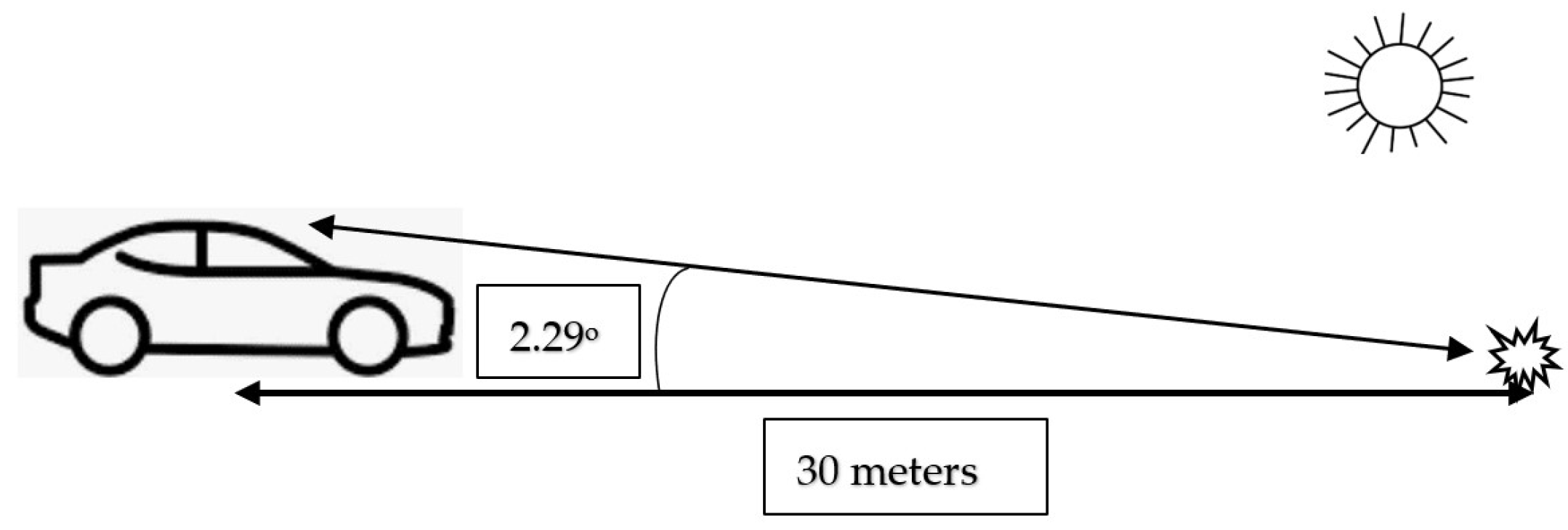
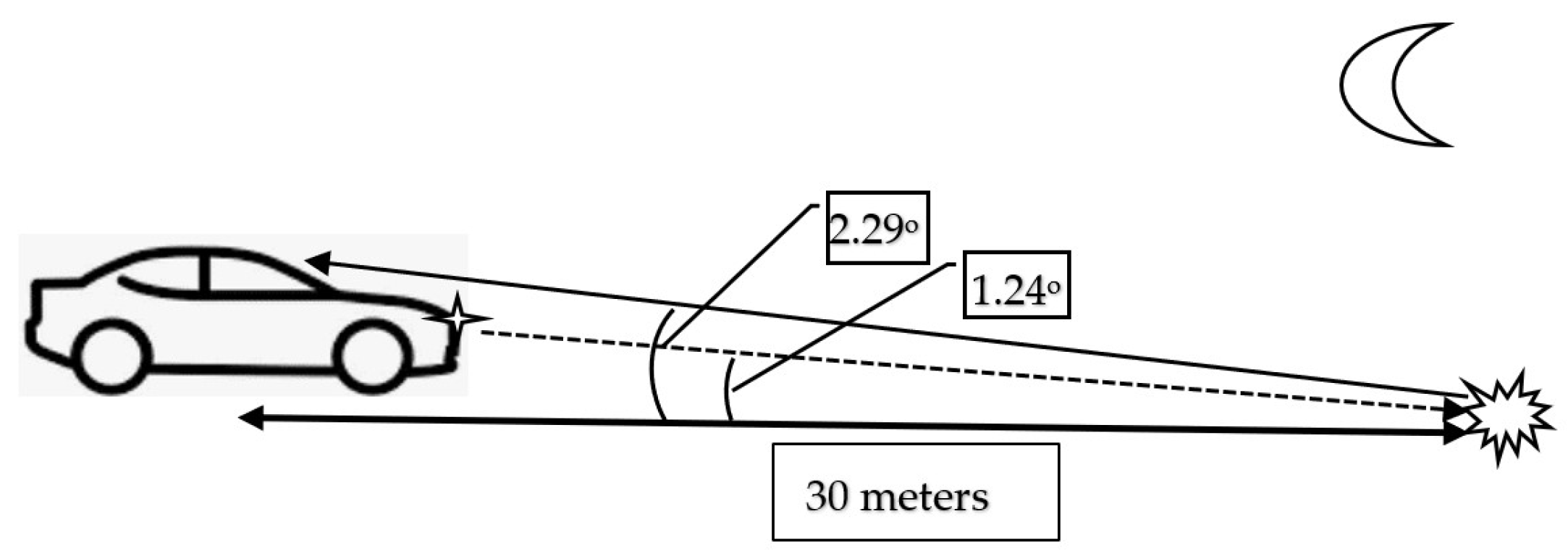
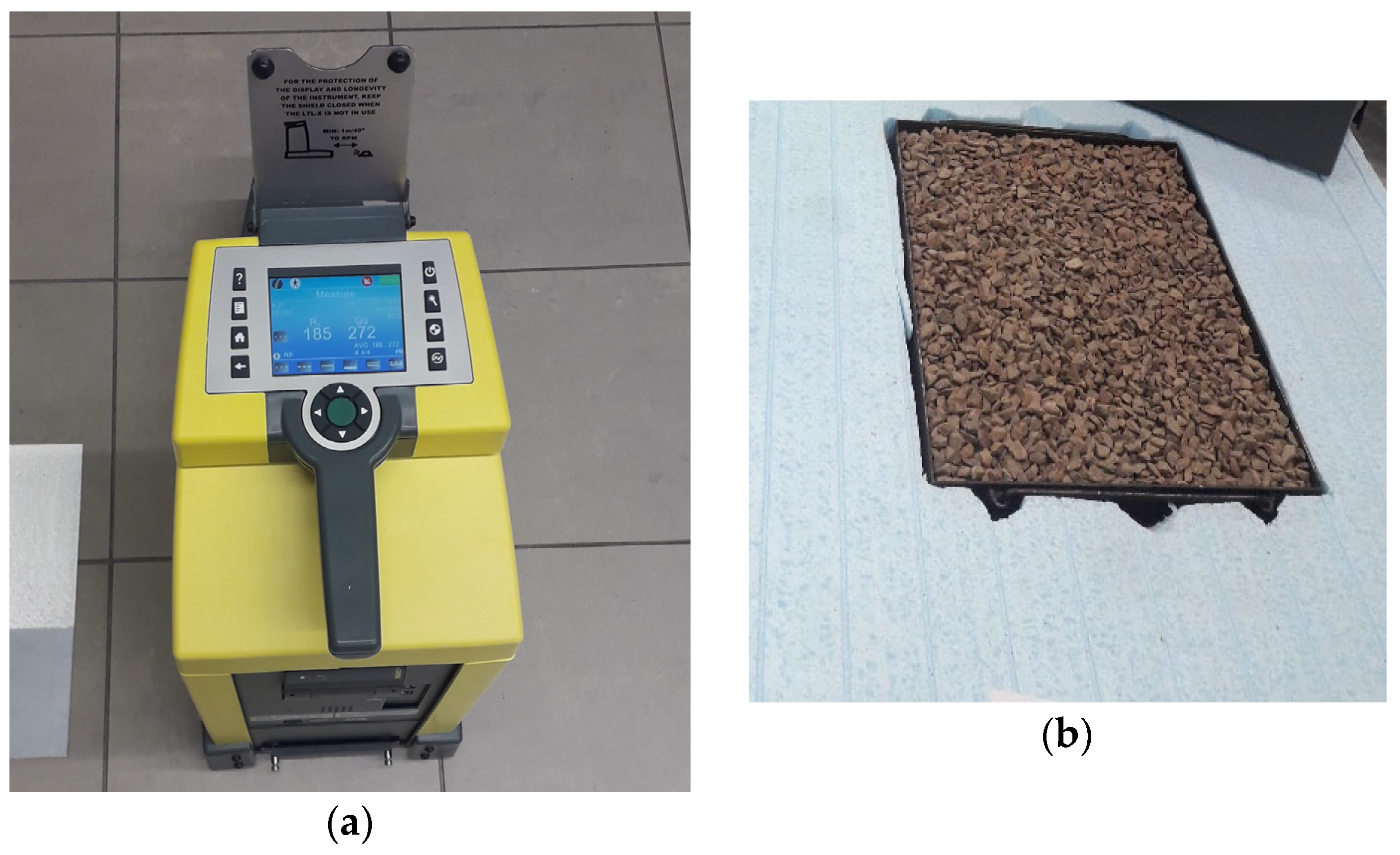
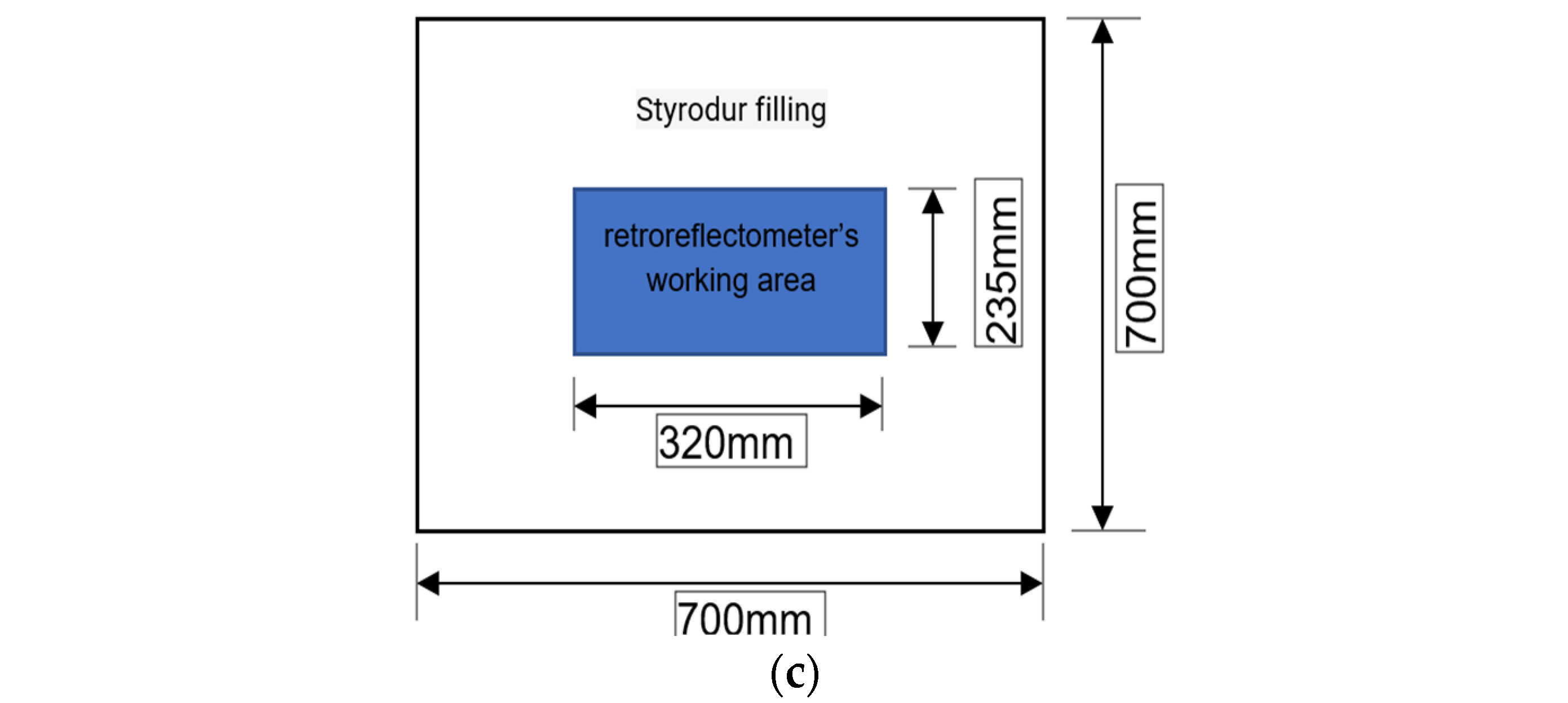
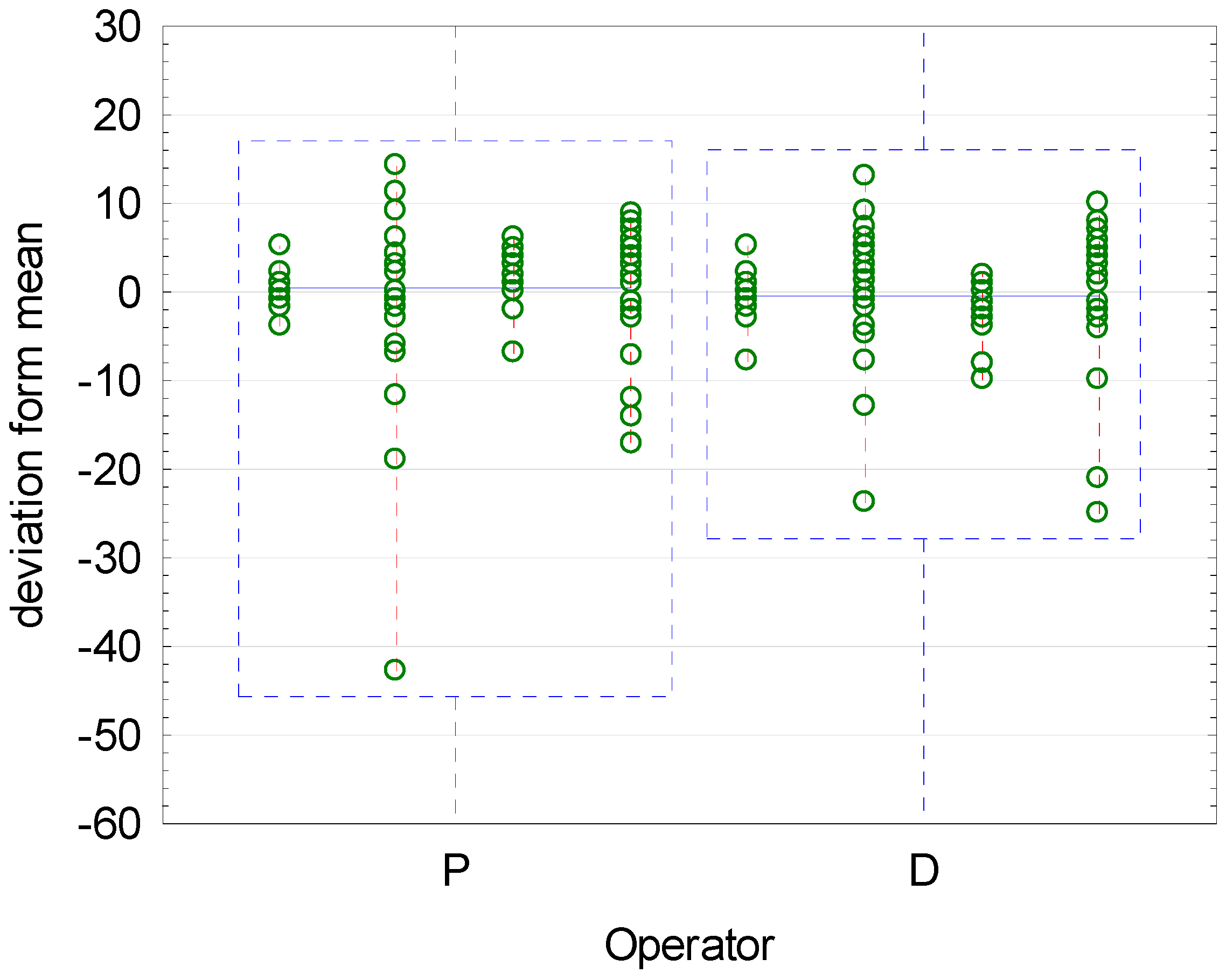



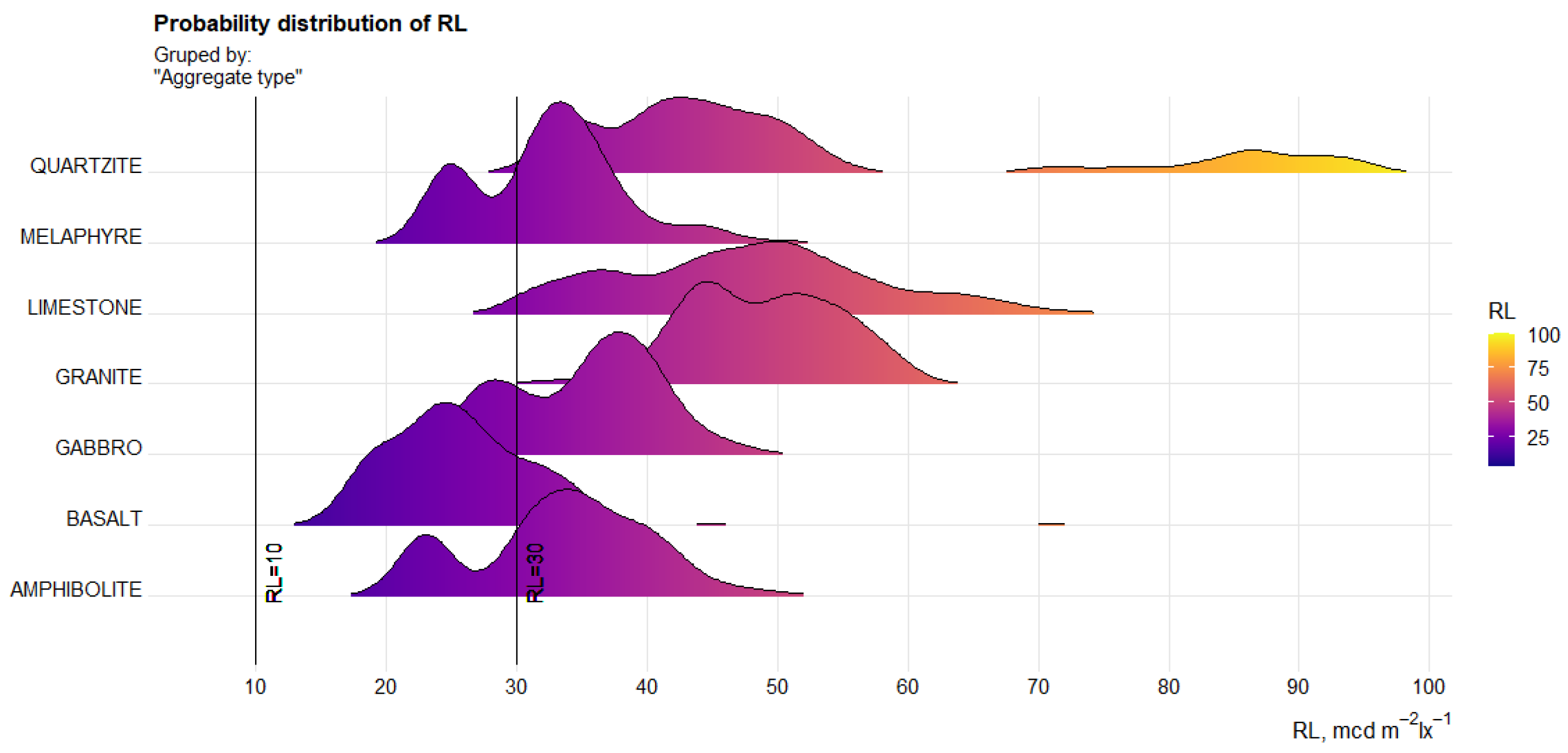
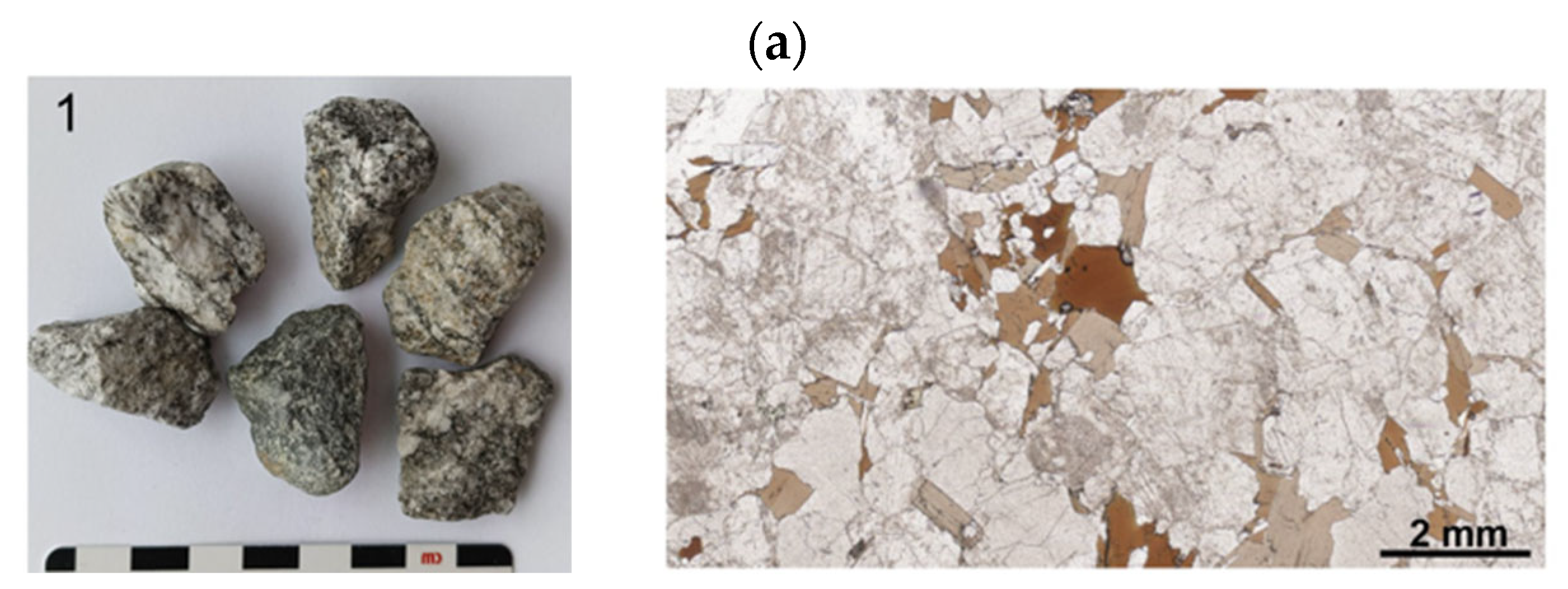
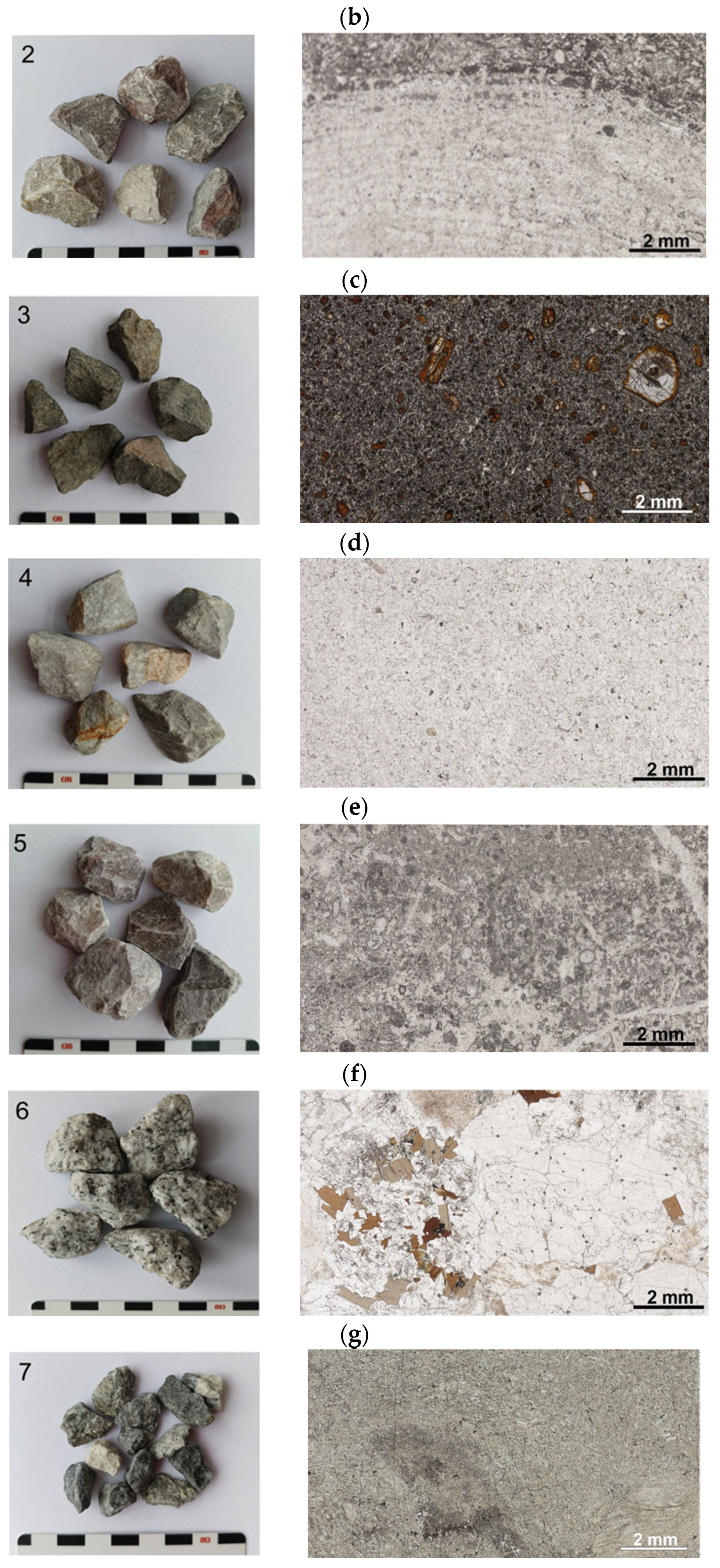
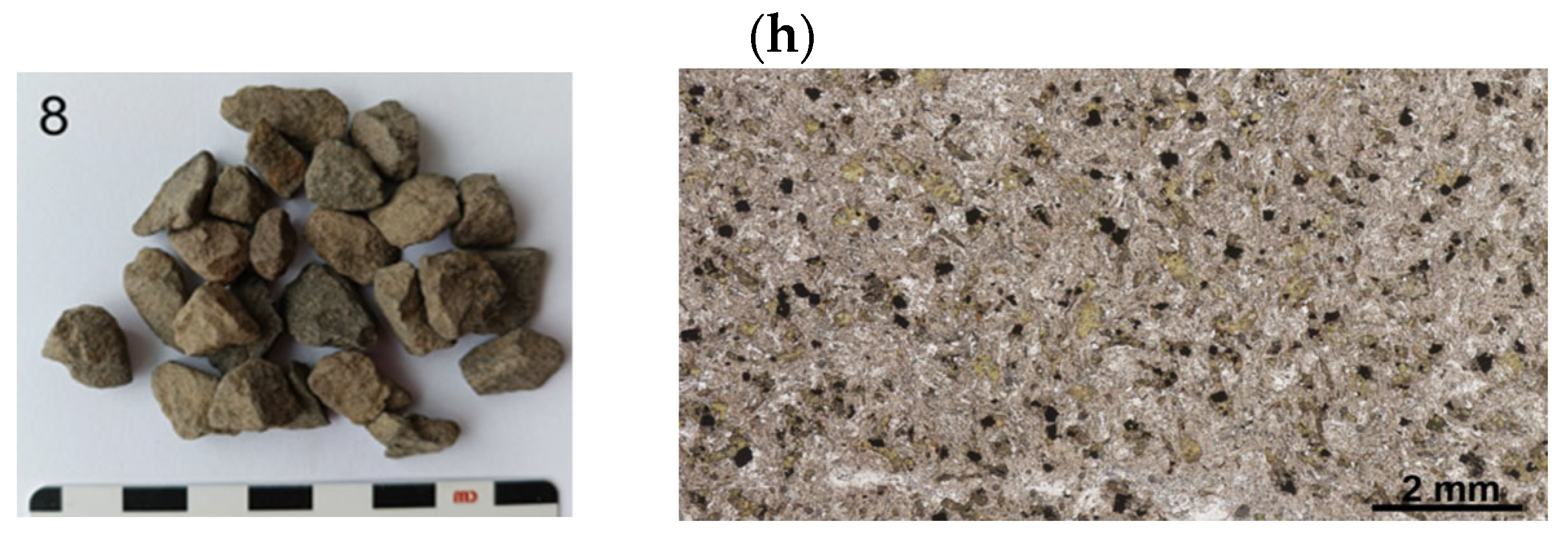
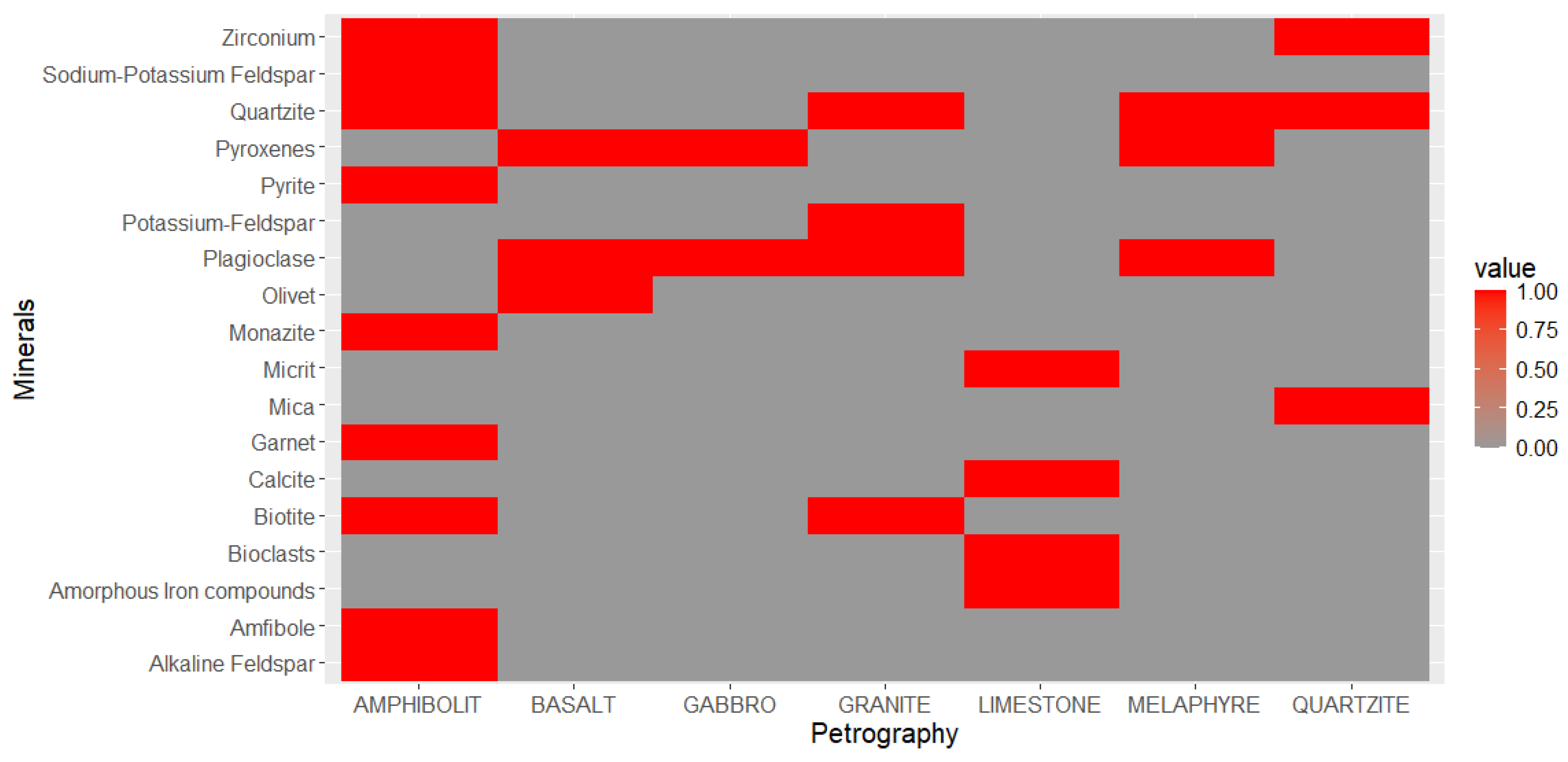
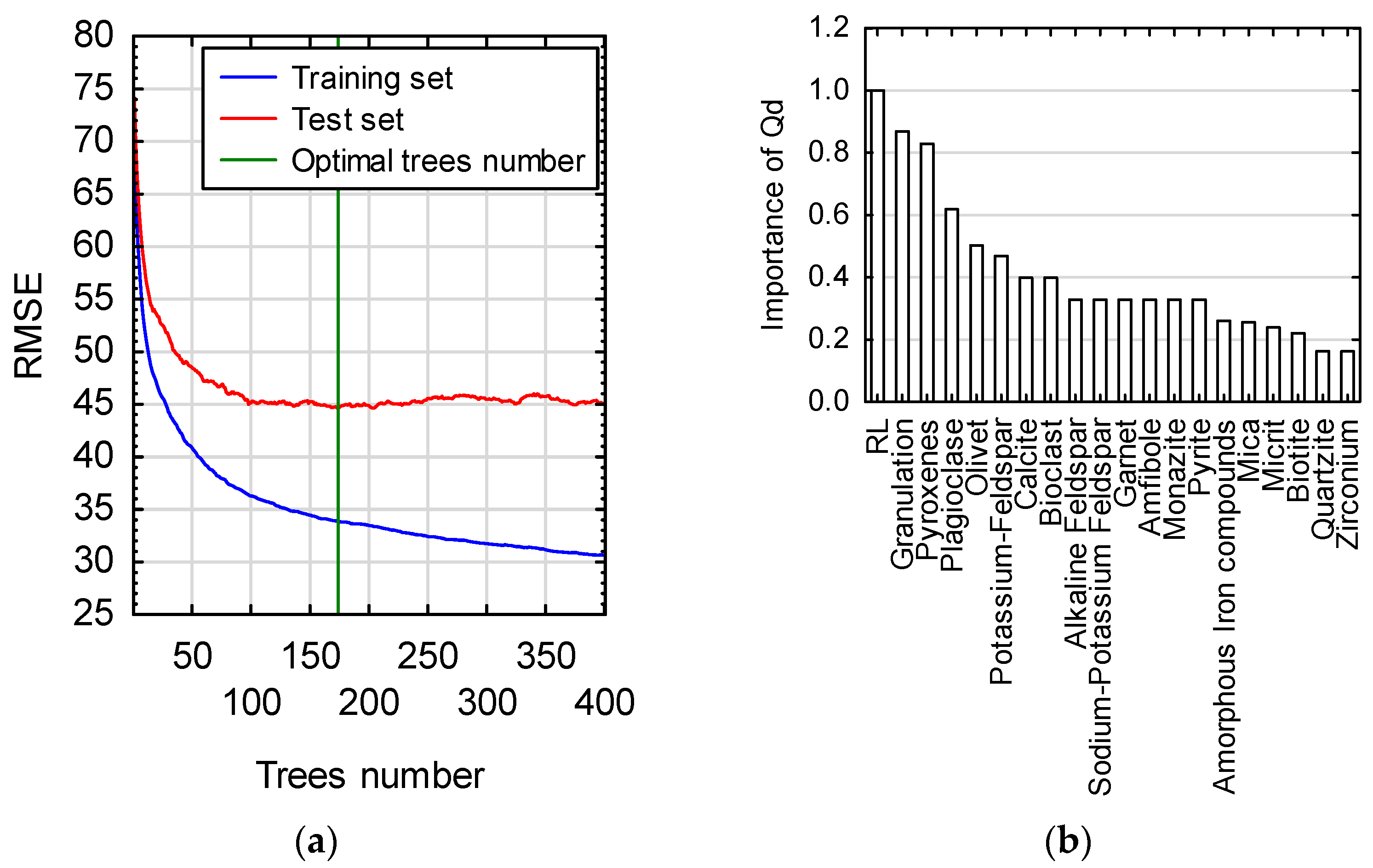

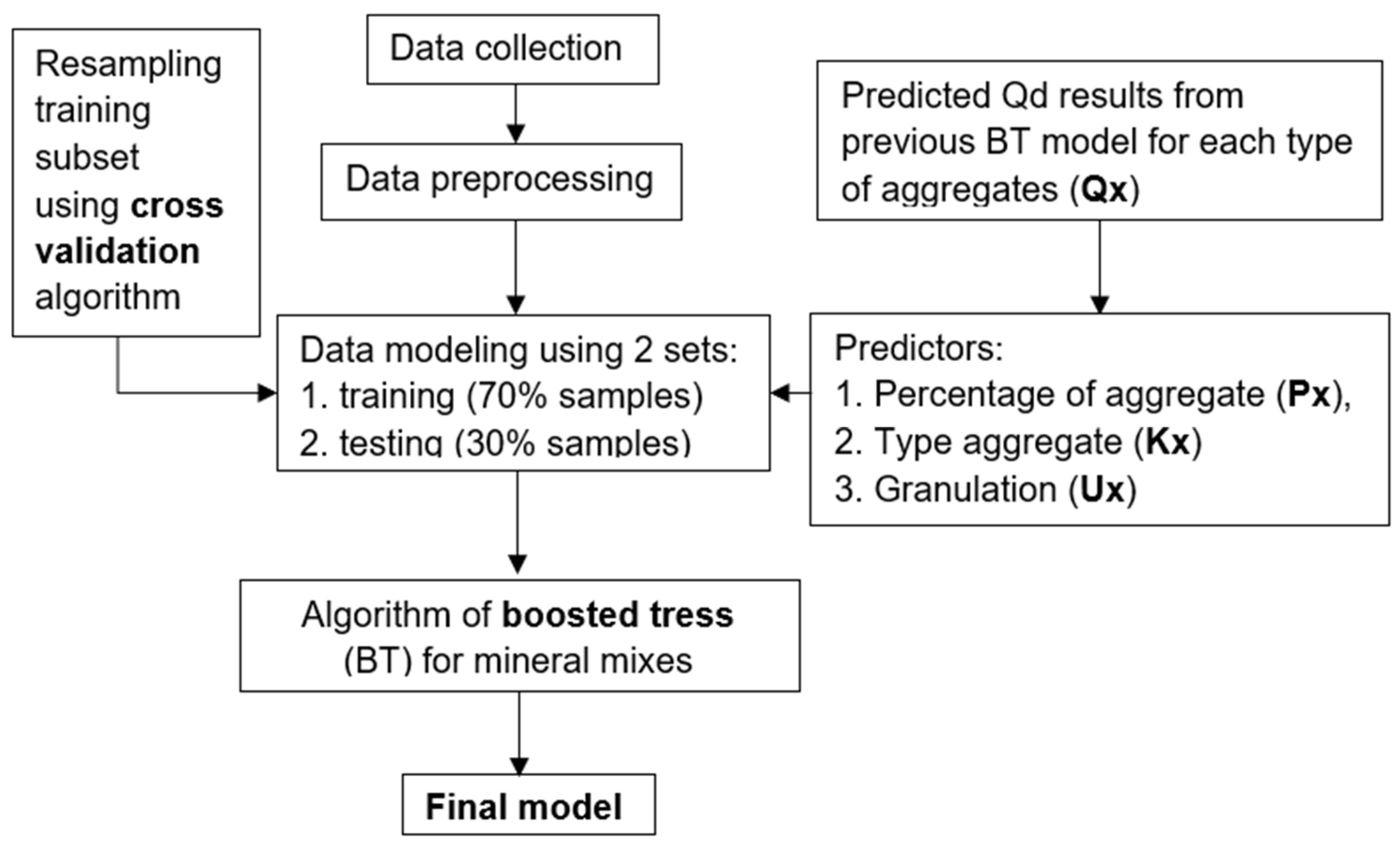
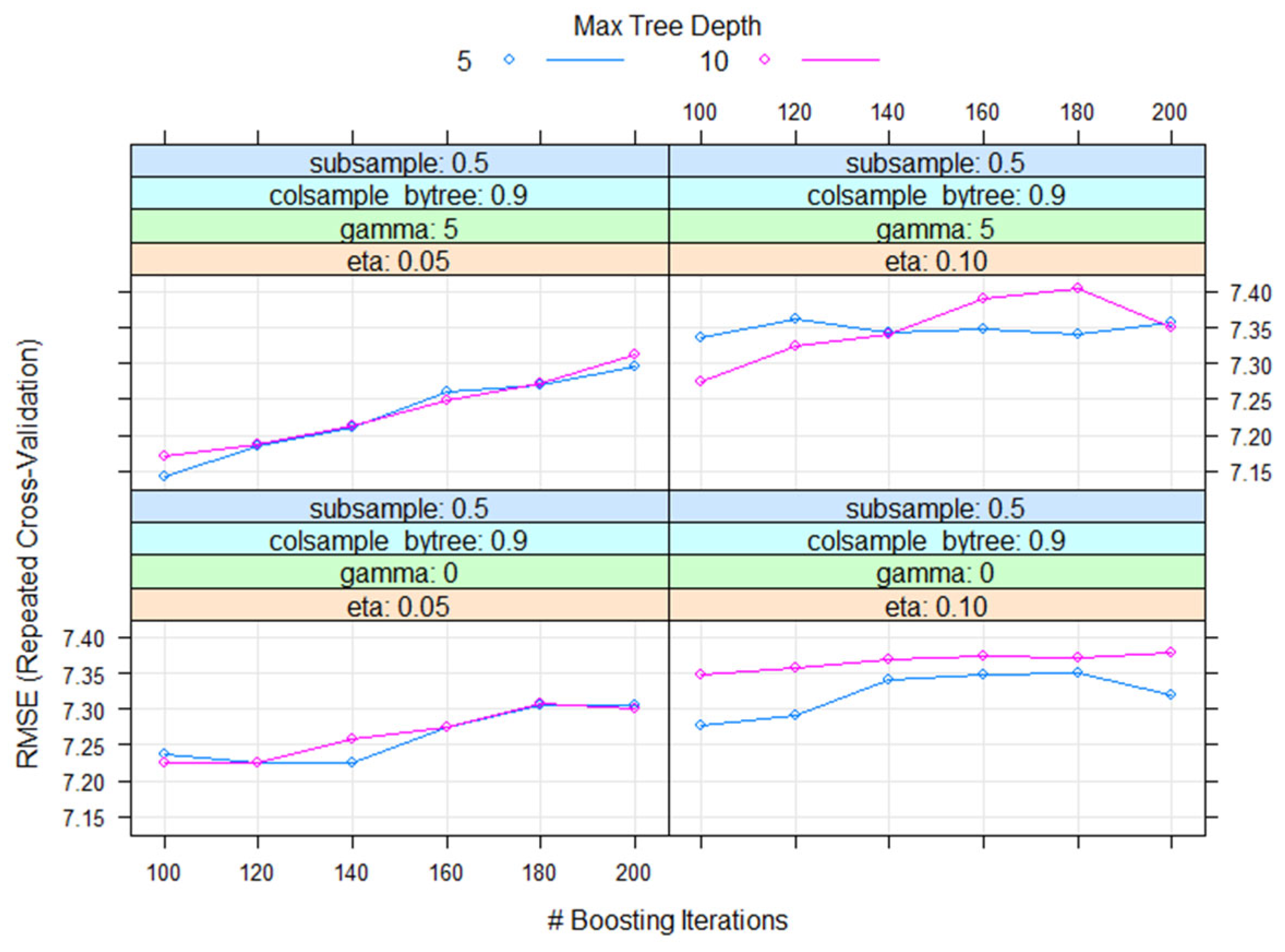
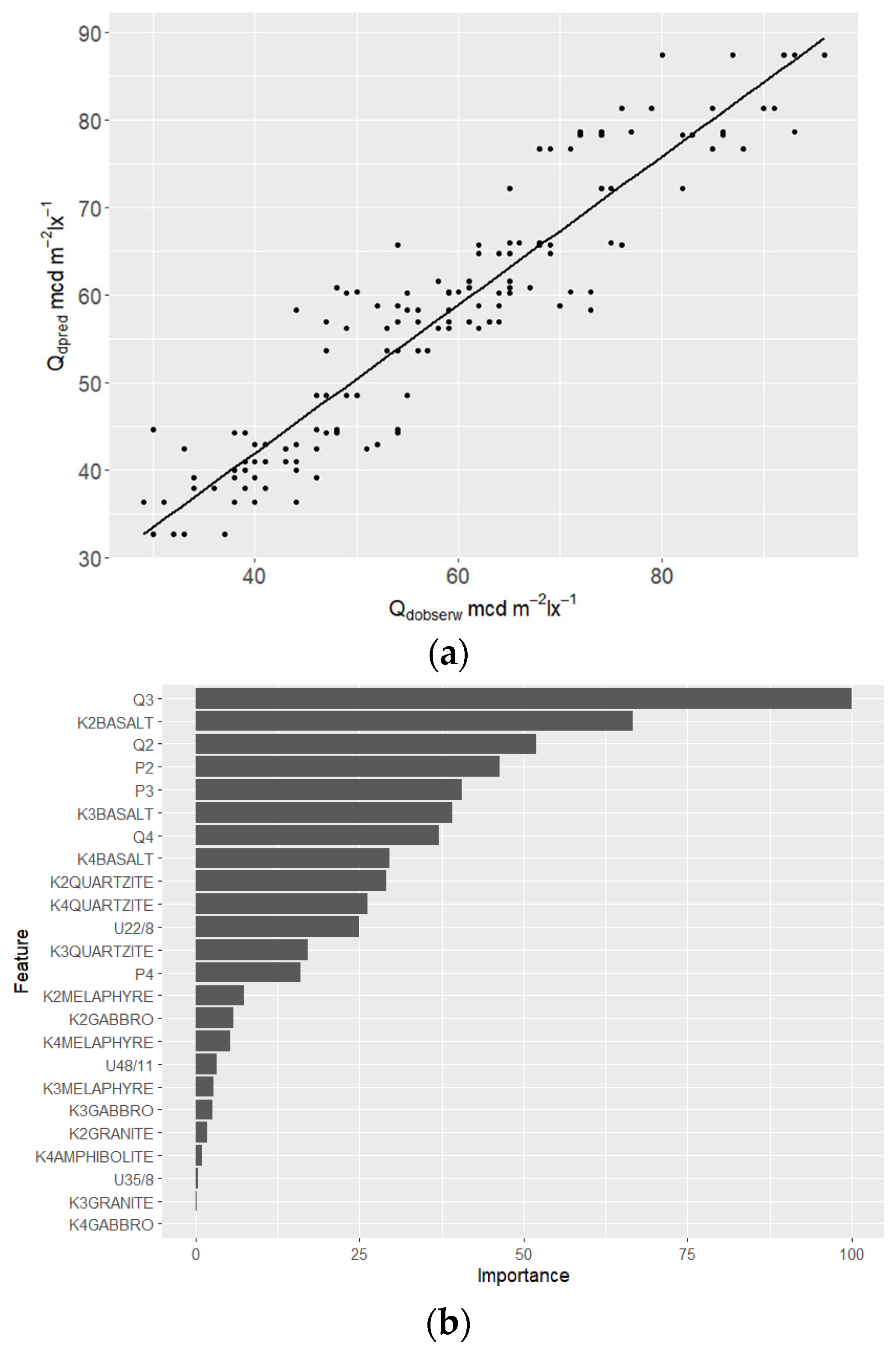
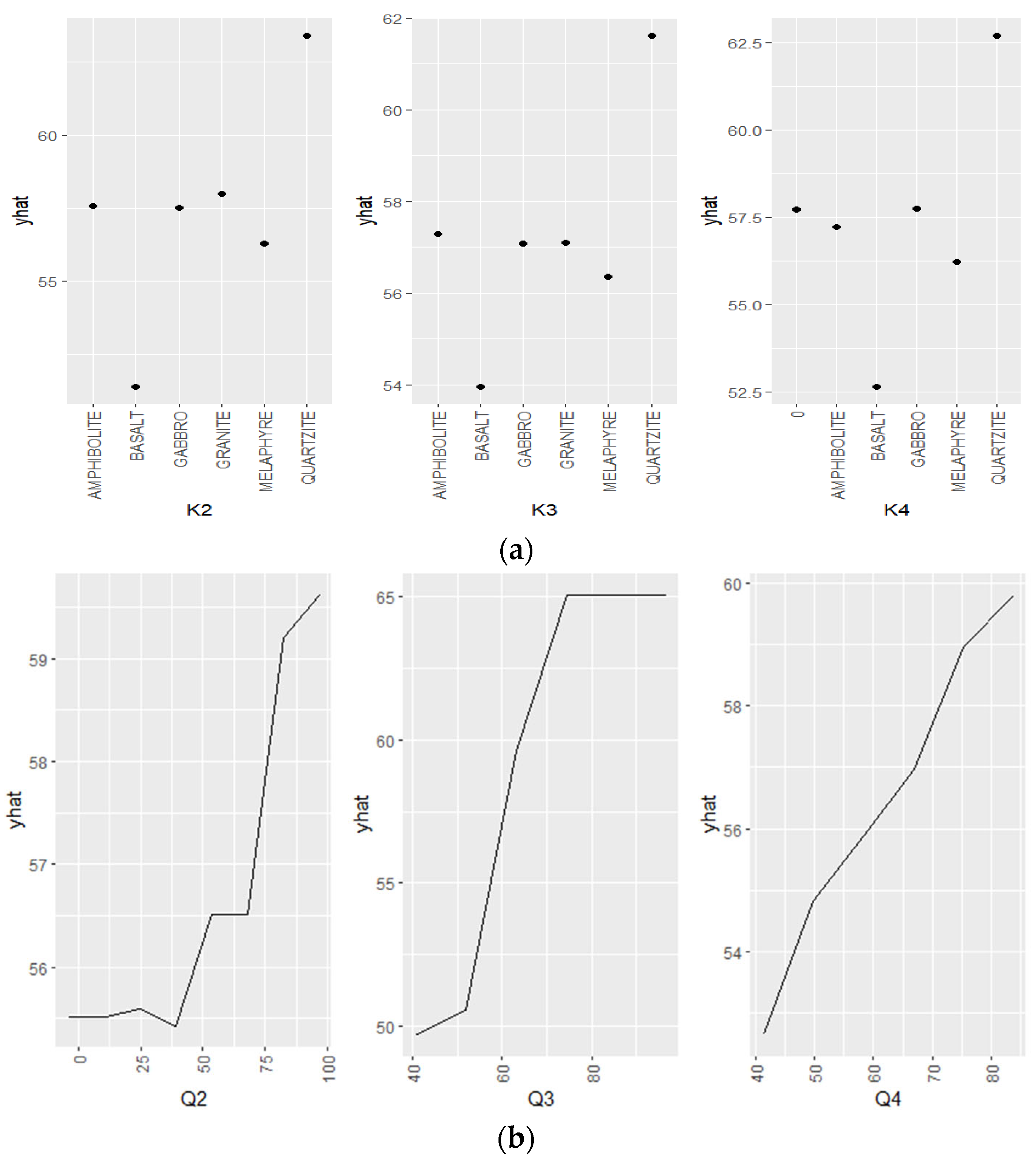


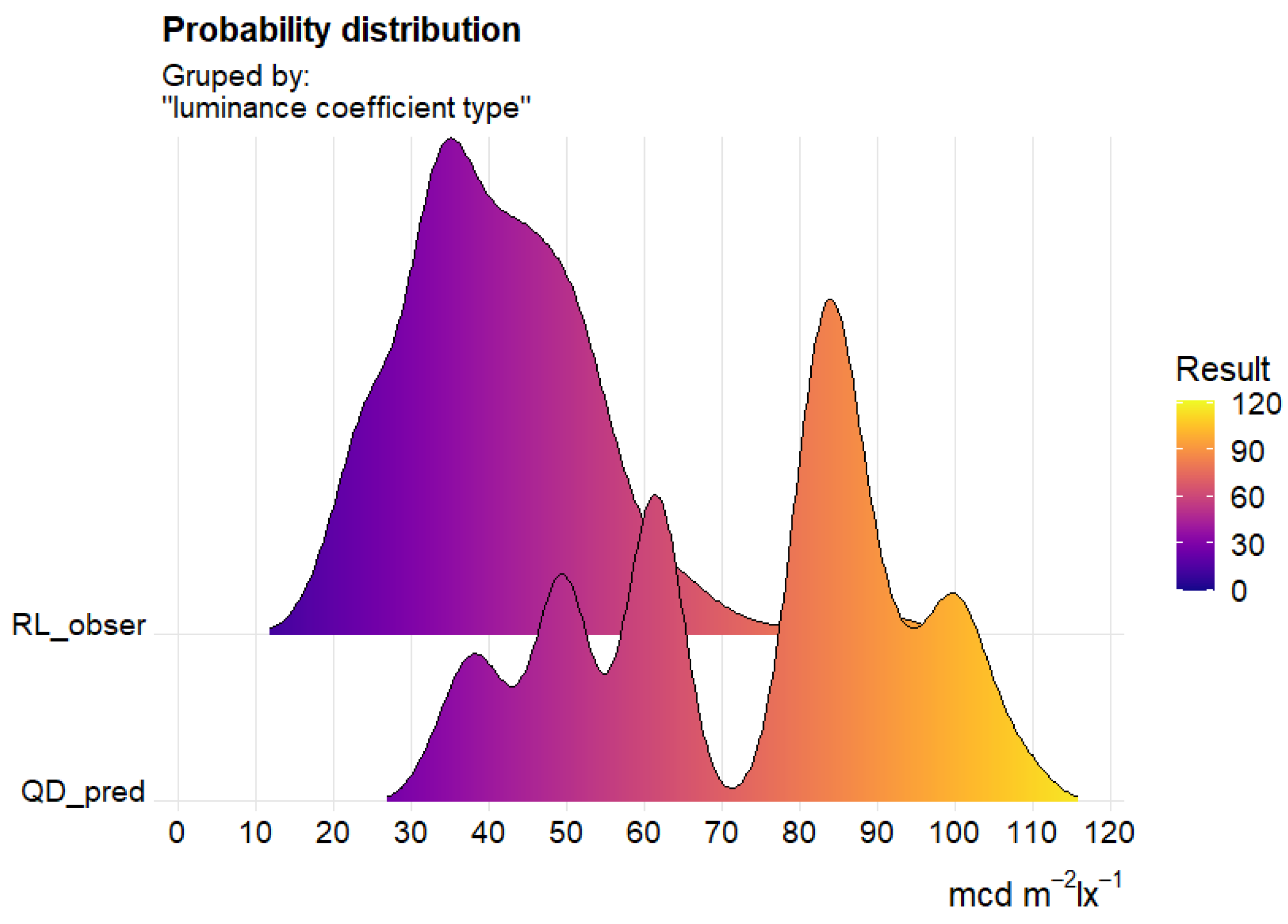
| No. | Type of Aggregate | Granulation | Type | Region |
|---|---|---|---|---|
| 1. | Amphibolite | 0/2, 5/8, 8/11 | metamorphic | Lower Silesia |
| 2. | Basalt | 2/5, 5/8, 8/11, 16/22 | igneous | Lower Silesia |
| 3. | Gabro | 2/5, 5/8, 8/11 | igneous | Lower Silesia |
| 4. | Granite | 2/8, 8/16, 16/22 | igneous | Lower Silesia |
| 5. | Quartzite Sandstone (Quartzite) 1 | 0/2, 2/5, 5/8, 8/11, 8/16 | sedimentary | Holy Cross Mountains |
| 6. | Palobasalt (Melaphyre) 2 | 0/2, 2/5, 5/8, 8/11, 8/16 | igneous | Lower Silesia |
| 7. | Limestone | 0/2, 2/8, 4/11, 5/11, 5/8, 8/11, 8/16, 16/22 | sedimentary | Holy Cross Mountains |
| No. | Type of Aggregate | Grain Size | LA [31] | PSV [32] | ρa [33] | Methylene Blue Test [34] | Grading of Filler Aggregates [35] | Flakiness Index [36] |
|---|---|---|---|---|---|---|---|---|
| 1. | Amphibolite | 0/2, 5/8, 8/11 | <25 | >56 | 2.84 | 5÷7 * | max. 16 */max. 2 ** | max. 20 ** |
| 2. | Basalt | 2/5, 5/8, 8/11, 16/22 | <10 | >50 | 2.96 | max. 1 ** | max. 18 ** | |
| 3. | Gabro | 2/5, 5/8, 8/11 | <15 | >50 | 2.63 ÷ 3.0 | max. 1 ** | max. 15 ** | |
| 4. | Granite | 2/8, 8/16, 16/22 | <15 | >50 | 2.65 | max. 1 ** | max. 15 ** | |
| 5. | Quartzite Quartzite | 0/2, 2/5, 5/8, 8/11, 8/16 | <25 | >56 | 2.64 | max. 14 */max. 1 ** | max. 14 ** | |
| 6. | Melaphyre | 0/2, 2/5, 5/8, 8/11, 8/16 | <15 | >56 | 2.75 | max. 14 */max. 1 ** | max. 18 ** | |
| 7. | Limestone | 0/2, 2/8, 4/11, 5/11, 5/8, 8/11, 8/16, 16/22 | 25 ÷ 30 | 44 ÷ 56 | 2.69 ÷ 2.72 | - | max. 16 */max. 2 ** | max. 17 ** |
| Source | Qd | RL | ||
|---|---|---|---|---|
| Value mcd⋅m−2⋅lx−1 | % of R&R | Value mcd⋅m−2⋅lx−1 | % of R&R | |
| Repeatability | 6.41 | 8.26 | 2.24 | 4.45 |
| Reproducibility | 0.12 | 0.01 | 0.6 | 0.32 |
| Part | 21.37 | 91.74 | 10.35 | 95.23 |
| Total R&R | 6.41 | 8.26 | 2.32 | 4.77 |
| Total | 22.31 | 100 | 10.61 | 100 |
| Metrics | BT Model with Petrography Analysis | The BT Model Included in the Paper by Mazurek et al. [15] |
|---|---|---|
| R2 | 0.97 | 0.96 |
| RMSE, mcd⋅m−2⋅lx−1 | 5.8 | 6.2 |
| MAE, mcd⋅m−2⋅lx−1 | 4.1 | 4.3 |
| Quantitative Dependent Variable | |
|---|---|
| Luminance ratio in diffuse light (Qd) | mcd⋅m−2⋅lx−1 |
| Surface reflectance (RL) | mcd⋅m−2⋅lx−1 |
| Quantitative independent variable (quantitative predictor) | |
| The luminance coefficient Qd for the aggregate (value derived from model described in Section 3.2), Qx | mcd⋅m−2⋅lx−1 |
| Percentage fraction of aggregate, Px | % |
| Qualitative independent variable (qualitative predictor) | |
| Aggregate grain size, Ux | 0/2, 2/5, 2/8, 5/8, 8/11 |
| Type of aggregate, Px | Limestone, Quartzite Sandstone, Melaphyre, Granite, Amphibolite, Basalt, Gabro |
| Number of fractions in mm, Kx | from 3 to 4 |
| Name | Mean Sum of Squares of Residuals (RMSE), Learning | Correlation, Learning | Selection for Evaluation |
|---|---|---|---|
| Reinforced trees | 35.69 | 0.93 | TRUE |
| Neural network | 37.43 | 0.92 | TRUE |
| Random forest | 91.5 | 0.85 | TRUE |
| C&RT | 158.61 | 0.71 | FALSE |
| MARS | - | - | FALSE |
| η | Max Depth | γ | Subsample | Min. Child Weight | Nrounds | RMSE | R2 | MAE |
|---|---|---|---|---|---|---|---|---|
| 0.05 | 5 | 5 | 0.5 | 3 | 120 | 7.1 | 0.82 | 5.7 |
Disclaimer/Publisher’s Note: The statements, opinions and data contained in all publications are solely those of the individual author(s) and contributor(s) and not of MDPI and/or the editor(s). MDPI and/or the editor(s) disclaim responsibility for any injury to people or property resulting from any ideas, methods, instructions or products referred to in the content. |
© 2024 by the authors. Licensee MDPI, Basel, Switzerland. This article is an open access article distributed under the terms and conditions of the Creative Commons Attribution (CC BY) license (https://creativecommons.org/licenses/by/4.0/).
Share and Cite
Mazurek, G.; Bąk-Patyna, P.; Ludwikowska-Kędzia, M. Modelling of the Luminance Coefficient in the Light Scattered by a Mineral Mixture Using Machine Learning Techniques. Appl. Sci. 2024, 14, 5458. https://doi.org/10.3390/app14135458
Mazurek G, Bąk-Patyna P, Ludwikowska-Kędzia M. Modelling of the Luminance Coefficient in the Light Scattered by a Mineral Mixture Using Machine Learning Techniques. Applied Sciences. 2024; 14(13):5458. https://doi.org/10.3390/app14135458
Chicago/Turabian StyleMazurek, Grzegorz, Paulina Bąk-Patyna, and Małgorzata Ludwikowska-Kędzia. 2024. "Modelling of the Luminance Coefficient in the Light Scattered by a Mineral Mixture Using Machine Learning Techniques" Applied Sciences 14, no. 13: 5458. https://doi.org/10.3390/app14135458
APA StyleMazurek, G., Bąk-Patyna, P., & Ludwikowska-Kędzia, M. (2024). Modelling of the Luminance Coefficient in the Light Scattered by a Mineral Mixture Using Machine Learning Techniques. Applied Sciences, 14(13), 5458. https://doi.org/10.3390/app14135458








